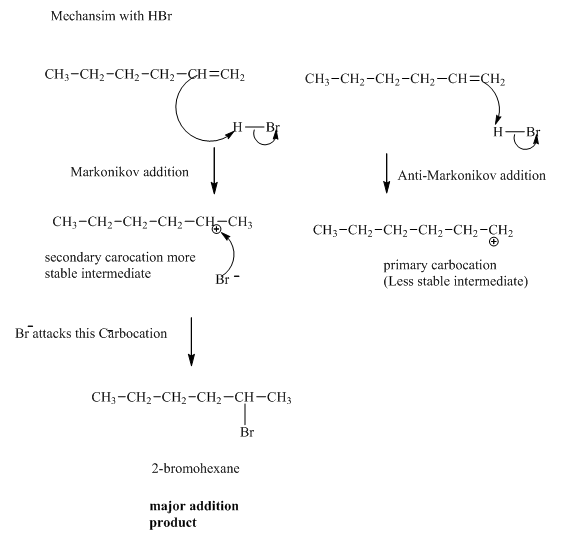
(a)
Interpretation: Structure of the major product expected from the ionic addition of

Concept introduction:

(b)
Interpretation: Structure of the major product expected from the ionic addition of

Concept introduction:Alkenes are considered electron rich and undergo addition reaction in presence of electrophilic halo acids. The product formed is governed by Markovnikov’s Rule. Rule suggests that negative part of halo acid HX must go to the carbon that has more alkyl substituents or less
(c)
Interpretation: Structure of the major product expected from the ionic addition of

Concept introduction:In first step of addition of
Want to see the full answer?
Check out a sample textbook solution
Chapter 10 Solutions
EBK EXPERIMENTAL ORGANIC CHEMISTRY: A M
- The reaction of Hbr with 2-methylpropene produces 2-bromo-2-methylpropane. What is the structure of the carbocation formed during the reaction?arrow_forward5. How many isomers are there Of C6H14? 6. Aside from a halogenated alkane, what other product results from the bromination of hexane? Write the formulaarrow_forwardDefine the Mechanism of the Radical Addition of HBr to an Alkene ?arrow_forward
- What is the structure of the principal organic product formed in the reaction of 1-iodopropane with NaOH?arrow_forwardWhich alcohols can be prepared as a single product by hydroboration–oxidation of an alkene? Which alcohols can be prepared as a singleproduct by the acid-catalyzed addition of H2O to an alkene?arrow_forwardWrite the structure of the major products in the following reactions and name them.arrow_forward
- Write the monobromination products of 1,4-dimethylcyclohexane and calculate the percentages of each product. Which is the major product?arrow_forwardWrite the structure of the compound that will be produced in the following reaction? CH3 –C ≡ C–CH2– CH2 – CH3 + 2HBr→arrow_forwardWhich alcohols can be prepared as a single product by hydroboration– oxidation of an alkene? Which alcohols can be prepared as a single product by the acid-catalyzed addition of H2O to an alkene?arrow_forward
- Draw the structural formula for the alkene with molecular formula C5H10 that will react to give the following productsarrow_forwardIgnoring stereochemistry, what is the major organic product of the reaction of 2,4-dimethylpentane, chlorine, and light?arrow_forwardProvide the principle organic product for the following reactions. If more than one product is formed indicate which one you expect to be the major product.arrow_forward
 ChemistryChemistryISBN:9781305957404Author:Steven S. Zumdahl, Susan A. Zumdahl, Donald J. DeCostePublisher:Cengage Learning
ChemistryChemistryISBN:9781305957404Author:Steven S. Zumdahl, Susan A. Zumdahl, Donald J. DeCostePublisher:Cengage Learning ChemistryChemistryISBN:9781259911156Author:Raymond Chang Dr., Jason Overby ProfessorPublisher:McGraw-Hill Education
ChemistryChemistryISBN:9781259911156Author:Raymond Chang Dr., Jason Overby ProfessorPublisher:McGraw-Hill Education Principles of Instrumental AnalysisChemistryISBN:9781305577213Author:Douglas A. Skoog, F. James Holler, Stanley R. CrouchPublisher:Cengage Learning
Principles of Instrumental AnalysisChemistryISBN:9781305577213Author:Douglas A. Skoog, F. James Holler, Stanley R. CrouchPublisher:Cengage Learning Organic ChemistryChemistryISBN:9780078021558Author:Janice Gorzynski Smith Dr.Publisher:McGraw-Hill Education
Organic ChemistryChemistryISBN:9780078021558Author:Janice Gorzynski Smith Dr.Publisher:McGraw-Hill Education Chemistry: Principles and ReactionsChemistryISBN:9781305079373Author:William L. Masterton, Cecile N. HurleyPublisher:Cengage Learning
Chemistry: Principles and ReactionsChemistryISBN:9781305079373Author:William L. Masterton, Cecile N. HurleyPublisher:Cengage Learning Elementary Principles of Chemical Processes, Bind...ChemistryISBN:9781118431221Author:Richard M. Felder, Ronald W. Rousseau, Lisa G. BullardPublisher:WILEY
Elementary Principles of Chemical Processes, Bind...ChemistryISBN:9781118431221Author:Richard M. Felder, Ronald W. Rousseau, Lisa G. BullardPublisher:WILEY





